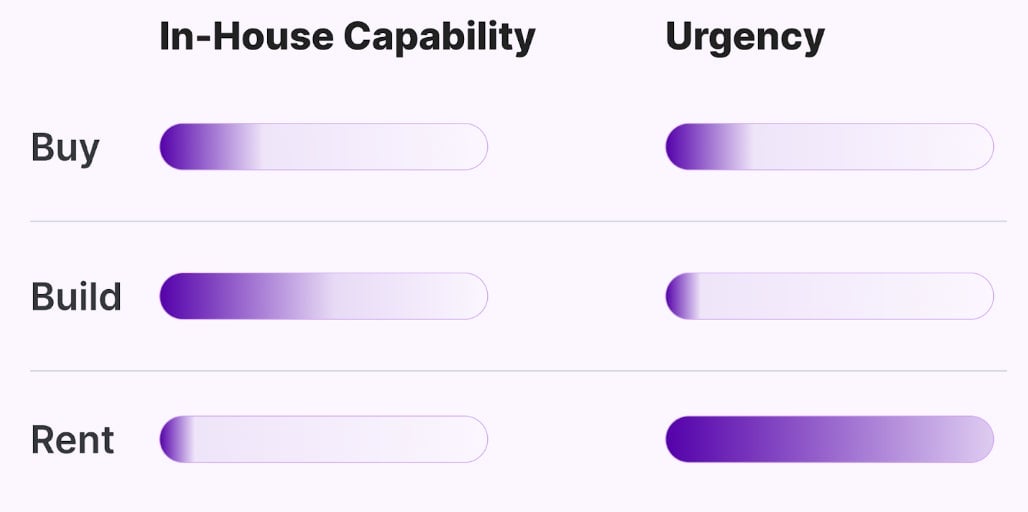3 ways your company can catch up in the race for AI talent
Determine when your company should build, buy, or rent talent

Most leaders understand that adopting AI is mission-critical but struggle with one big, outstanding talent question: How to fill AI skills gaps.
Suggested Reading
The AI talent market is exploding. Job posts that mention “generative AI” on Adzuna have increased by over 3300% since January. Netflix made headlines by posting an AI job paying $900,000 a year. With AI added to the picture, McKinsey predicts that 30% of hours worked today could be automated by 2030.
Related Content
Enterprise leaders have three main options for sourcing AI talent: They can upskill current employees—let’s call that the “build” option. They can hire from outside—”buy.” Or they can engage a talent partner on a contract basis—”rent.”
Build, buy, or rent
We’ve developed a simple rubric to help determine which tactic should be your principal strategy and which should serve as secondary and tertiary strategies.

There are two primary variables. The first is urgency: How quickly you must develop AI capabilities to keep pace with the competition. The second is talent capabilities. Do you already have hundreds of AI builders in place? Or do you struggle to attract in-demand tech talent? Depending on urgency and capabilities, building, buying, or renting will be the best strategy. But really, every talent strategy should include all three.
Build: Upskill your current employees—After all, you don’t need a PhD to master GPT
Pros: Upskilling is one of the nine actions McKinsey identified as essential for CIOs and CTOs attempting to harness the power of generative AI in their workforce.
Cons: The downside of upskilling is that it takes time and is not the same as bringing in niche expertise from outside the organization. There’s a ceiling on how far upskilling can take most current employees.
No matter where you are in your AI journey, upskilling your existing team with AI capabilities should be table stakes. A recent paper from BCG and a group of business school professors from Harvard, Wharton, and MIT found a 40% increase in quality amongst consultants when leveraging GPT-4.
Enterprises must adopt AI tools across departments, not just in IT. And because of its novelty, generative AI is a new skill for everyone—even those ML PhDs. Some of the best generative AI engineers are just great software engineers who taught themselves AI.
Lisa Britt, the chief human resources officer at Thermo Fisher Scientific, a massive medical equipment provider, has an entire team dedicated to upskilling internally on generative AI and sharing learning on the associated risk. Thermo Fisher also offers employees intro courses on AI, machine learning, and natural language processing.
“From a talent perspective, colleagues will learn to leverage this new technology while protecting our confidential information and intellectual property,” Britt said. “Specifically, the emerging skills required are skilled prompt creation balanced with expertise to validate and refine outcome accuracy.”
Buy: Recruit and tire AI/ML talent—the wise move in the long run
Pros: Establishing and growing a core team of technologists is necessary for the era in which software has already eaten the world.
Cons: Top-performing tech talent often doesn’t want to go work for big companies with lots of checks and balances.
When it comes to building with AI, upskilling won’t be sufficient on its own. There’s no way around it: Enterprises must recruit and hire AI/ML talent to invest in long-term capability. It’s hard to imagine an enterprise company winning through the next decade without a strong core AI team to lead transformation and set standards for implementation that non-tech teams across the company can follow or without the innovation that comes from bringing in outside perspectives.
JPMorgan advertised 3,651 AI-related jobs between February and April, ahead of other banks. This is just after the bank filed a patent application for an AI tool called IndexGPT.
However, large enterprises still struggle to attract top Silicon Valley talent. As McKinsey pointed out, “An expert developer is more than ten times more productive than a novice. But many of these top engineers can’t work in traditional organizations where a surfeit of managers and bureaucratic processes inhibit them from doing good work at pace.”
Rent: Engage a talent partner and start building today
Pros: You can ramp up quickly and deliver an MVP in a matter of months—about the same time it would take to hire and onboard the traditional way.
Cons: Renting talent is not a substitution for building long-term capability.
In the case where you need to move urgently on an AI prototype or product, partnering with an external partner provides three crucial things:
1. Quality: You get talent that’s difficult to hire full-time and has seen a lot of different use cases, bringing a high degree of cognitive diversity and upskilling to your team.
2. Flexibility and cost efficiency: Building AI involves a different kind of product development cycle. You won’t know exactly what you need off the bat. You want to start small, remain flexible, and iterate.
3. Speed: Smaller teams deliver innovation faster. One thing we’ve learned from OpenAI is that, as Sam Altman said in Melbourne, “Innovation is easier with a relatively small team that has to make a decisive and clear concentrated bet, and that doesn’t tolerate any mediocre performers.”
The downside, of course, is that independent workers will eventually move on. And to build in-house capacity over the long term, you’ll have to hire full-time and upskill as well. The upshot is that you can start building in weeks instead of months.
From our own experience, we’ve seen that independent product talent may not want to work for a non-tech enterprise company as a full-time employee. They are attracted to the idea of building products that have a meaningful impact on people’s lives and improving key sectors, like education and healthcare, where AI holds tremendous potential.
Raphael Ouzan is the founder and CEO of A.Team, a team formation platform that enables tech leaders to assemble high-performing teams from its members-only network of 8,000+ product builders and build transformative products. Raphael previously founded BillGuard, BlockNation, and Israeli Tech Challenge, and was named 30 under 30 by Forbes and a Global Shaper by the World Economic Forum.